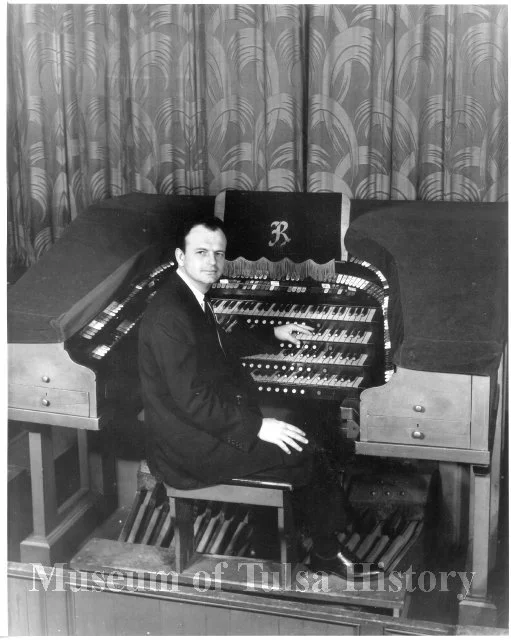Good Design, Done Right: Remembering Edward W. Saunders
While some architects chased headlines with towering statements and signature styles, others quietly built the very fabric of a city, one steady structure at a time. Edward W. Saunders was definitely one of the latter. You might not know his name instantly, but his work profoundly shaped the Tulsa skyline during its most dynamic decades. From the grand oil mansions and striking Deco-era storefronts to his later years as the city building inspector, Saunders left behind a legacy that's both broad and surprisingly enduring.
Born in Troy, Ohio, in 1880, Saunders landed in Tulsa in 1919 after honing his skills in architecture at the University of Pennsylvania. He arrived with a solid grasp of classical design, but what really set him apart was his knack for adapting. Tulsa in the 1920s was absolutely booming, and Saunders met that moment head-on, designing everything from elegant revivalist homes to sleek modern commercial buildings, quickly building a client list among the city’s new elite.
He got his start in Tulsa through partnerships, first with Cortland L. Butler and later with Marshall C. Cross. These collaborations helped him gain a foothold in what was a pretty competitive local scene. By 1925, he was striking out on his own and stayed incredibly active well into the 1950s.
Among his most captivating residential designs are three homes that really show his range and taste. Take the Patrick M. Kerr House, finished in 1921 in the Riverview neighborhood. It’s a beautiful Mission Revival home, all white stucco, red tile roof, and those distinctive blue tile insets. It’s still standing today – now cleverly subdivided into apartments – and much of its original charm is wonderfully preserved. Then there’s the Carl W. Gillette residence in the Yorktown section of Maple Ridge, which remains a private home in 2025, lovingly cared for as a prime example of early Tulsa architecture. And while it wasn't his design, Saunders had a close connection to the iconic Stebbins-Talbot mansion at 1030 East 19th Street through his client, Ralph Talbot. That home is still a residential landmark, occasionally featured on historical tours.
Saunders also played a significant role in shaping Tulsa’s commercial look. In 1930, he designed Milady’s Cleaners, a small but remarkably eye-catching storefront right on Route 66. Its Art Deco brickwork and stepped parapet made it truly pop for passing motorists. Nearly a century later, it still does! Milady’s is one of the best-preserved Deco storefronts in the city and now houses a local retail business, La Maison, continuing to serve the neighborhood with unmistakable style.
One of his earlier commercial ventures was the Ritz Theater, constructed in 1926 at 4th and Boulder. Saunders handled the overall building design, while the legendary theater architect John Eberson crafted its stunning interior. The Ritz boasted a lavish auditorium designed to feel like a Mediterranean courtyard, complete with painted skies and intricate decorative plasterwork. Sadly, the theater was torn down in the 1960s, and the office block followed in the 1970s. But memories of the Ritz live on through vintage photos, old newspaper ads, and even a few salvaged architectural details tucked away in local collections.
By the late 1940s, Saunders transitioned into a different kind of influential role. From 1949 to 1956, he served as Tulsa’s City Building Inspector, overseeing construction standards during a period of intense suburban expansion. While he wasn't sketching out major projects anymore, his decisions impacted pretty much everything being built in the postwar era. His deep knowledge, fairness, and consistent approach earned him widespread respect, making him a truly trusted figure in both architectural and civic circles.
Of course, you can’t talk about Saunders without mentioning the Gillette-Tyrrell Building, later known as the Pythian. This 1930 structure remains his most recognized work. Today, it’s home to commercial offices and studios, and its dazzling Deco lobby is still largely intact. Listed on the National Register of Historic Places, it’s become a frequent stop on walking tours and photo walks, drawing admirers with its vibrant polychrome terra cotta, custom chandeliers, and distinctive zigzag flooring.
Pythian Building - photo curtsey of The Museum of Tulsa History
But Saunders' immense contribution to Tulsa really can’t be boiled down to just one building.
He was a true bridge between the old and the new, between tradition and innovation. He could hand an oil baron a stately Tudor home, then turn around and design a sleek Deco storefront for a neighborhood cleaner. He could envision a grand office tower, then meticulously review suburban plans to ensure they followed every code. He worked in many styles, yes, but he was always guided by one simple principle: good design, done right.
Edward W. Saunders passed away in 1964, just as appreciation for Tulsa’s incredible Art Deco legacy was starting to gain traction. Today, his name might not resonate as loudly as some others, but his buildings absolutely still stand, and his influence is undeniably felt. Whenever we admire the decorative flourishes of a Deco lobby or the quiet elegance of a Revival home, in a way, we’re still seeing Tulsa through Saunders’ eyes.






